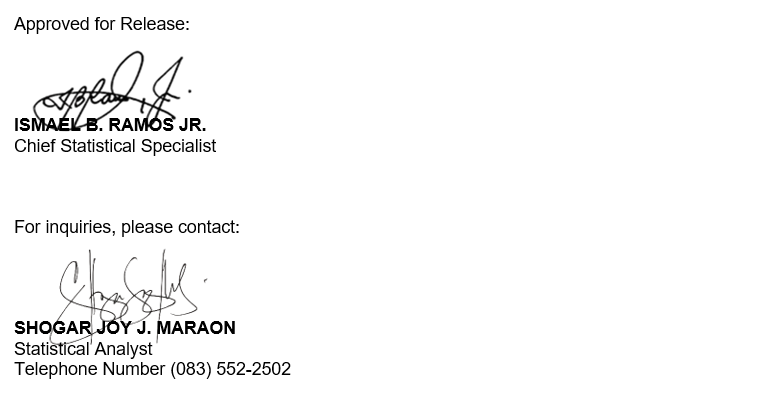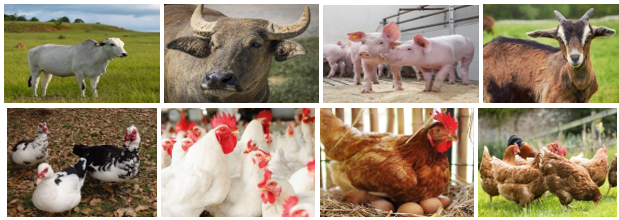
Highlights
As of 01 January 2025, the province recorded a 12.3 percent increase in its total livestock and poultry inventory. The number of heads and birds rose to an estimated 1,039,465 compared to the 925,606 heads/birds as of 01 January 2024. (Table 1)
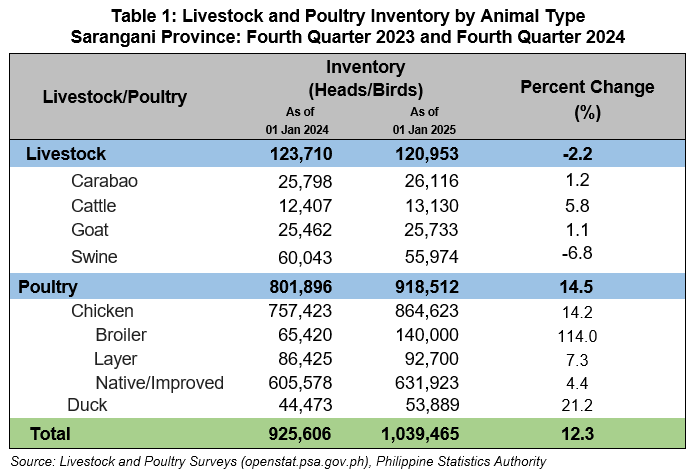
Livestock Inventory in Sarangani Province down by 2.2 percent
The province’s livestock inventory decreased by 2.2 percent in the fourth quarter of 2024, a drop from 123,710 heads in the same period of 2023 to 120,953 heads. The decline was mainly due to a decrease in the swine population, which, despite the decline, remains the largest contributor to the overall livestock inventory with 55,974 heads.
The total livestock inventory was comprised of carabao, cattle, goat, and swine. Except for swine, other livestock commodities posted growth in the fourth quarter of 2024. Cattle recorded the highest increase of 5.8 percent. This was followed by carabao and goat at 1.2 percent and 1.1 percent, respectively, in the fourth quarter of 2024. (Table 2)
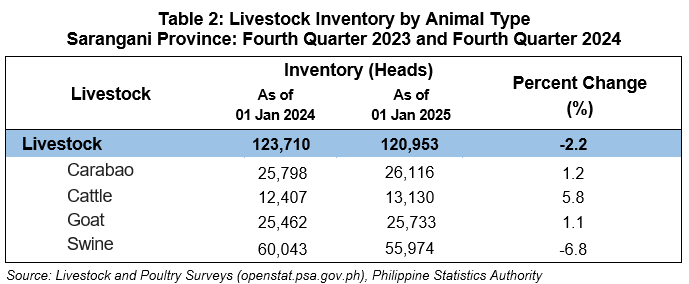
Carabao inventory grows marginally by 1.2 percent
Carabao inventory was estimated at 26,116 heads in the fourth quarter of 2024, reflecting a slight increase of 1.2 percent compared to 25,798 heads in the same period of the previous year, as shown in Figure 1 below.
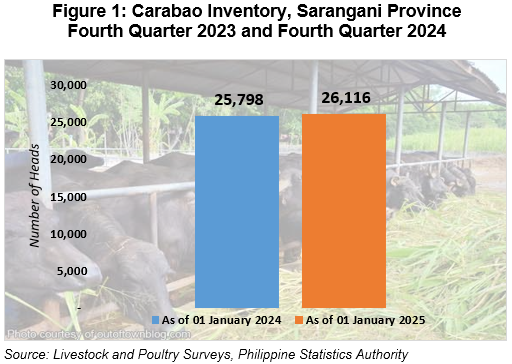
Cattle inventory rises by 5.8 percent
Cattle inventory in the province rose by 5.8 percent in the fourth quarter of 2024, or 723 heads higher than the level in the same quarter of the preceding year at 12,407 heads, as illustrated in Figure 2 below.
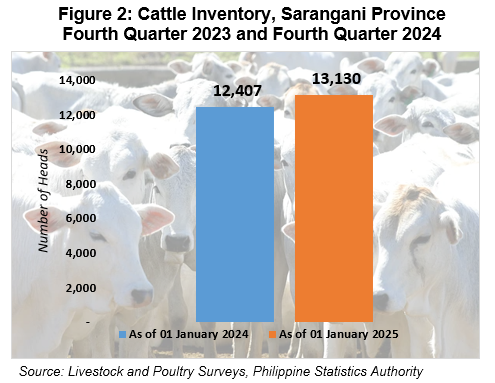
Goat inventory slightly increases by 1.1 percent
The province’s goat inventory was estimated at 25,733 heads in the fourth quarter of 2024, reflecting a slight increase of 1.1 percent compared to 25,462 heads in the same period of 2023, as shown in Figure 3 below.
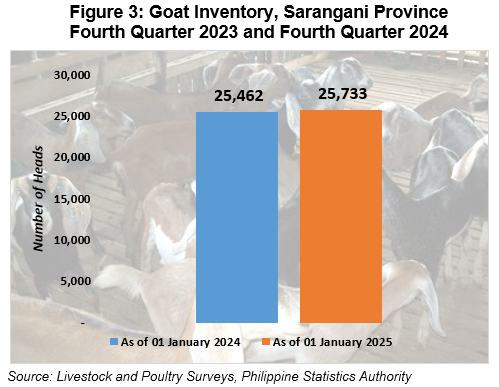
Swine population declines by 6.8 percent
Swine inventory was estimated at 55,974 heads, marking a 6.8 percent decline in the fourth quarter of 2024 compared to 60,043 heads recorded in the fourth quarter of 2023, as shown in Figure 4 below.
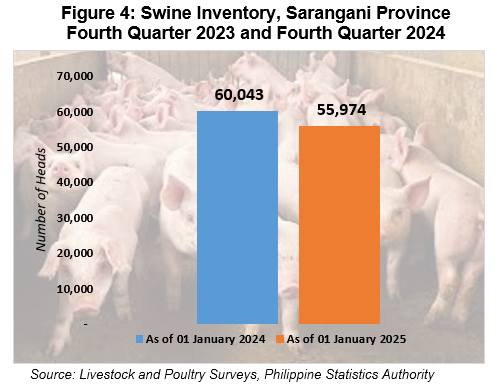
Poultry Inventory in Sarangani Province grows by 14.5 percent
The province’s poultry products posted a growth of 14.5 percent in the fourth quarter of 2024, increasing to 918,512 birds from 801,896 birds in the same quarter of 2023 as shown in Table 3.
Native/improved chicken accounted for the largest share of Sarangani’s poultry inventory with 631,923 birds in the fourth quarter of 2024. This was followed by broiler chicken at 140,000 birds, and layer chicken at 92,700 birds. Duck has the smallest share of the total inventory at 53,889 birds. Despite the lower number, duck registered a double-digit growth during the period.
The growth in the poultry sector was primarily driven by the sharp increase of 114.0 percent in the inventory of broiler chicken. Also, duck inventory increased significantly by 21.2 percent, followed by layer chicken with 7.3 percent. Native/improved chicken recorded the lowest growth among the poultry commodities with a 4.4 percent increase from its inventory in the fourth quarter of 2023. (Table 3)
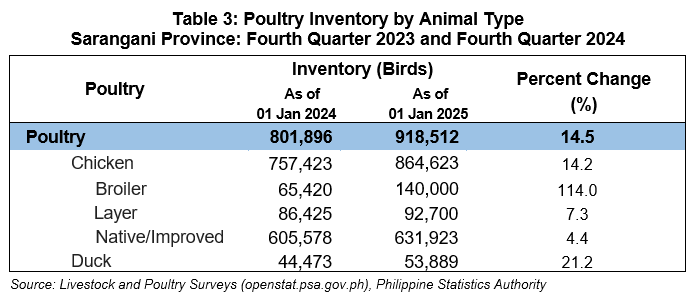
Chicken inventory in Sarangani Province rises by 14.2 percent
The total chicken inventory in Sarangani Province rose by 14.2 percent, growing from 757,423 birds in the fourth quarter of 2023 to 864,623 birds in the same period of 2024. (Table 3)
The growth was largely driven by a 114.0 percent surge in broiler chicken, which jumped from 65,420 birds in the fourth quarter of 2023 to 140,000 birds in the same period of 2024. The stocks of layer chicken also registered an increase of 7.3 percent from 86,425 birds in the fourth quarter of 2023 to 92,700 birds in the fourth quarter of 2024. Native chicken posted the smallest growth among the chicken inventories, with a 4.4 percent increase. (Figure 5)
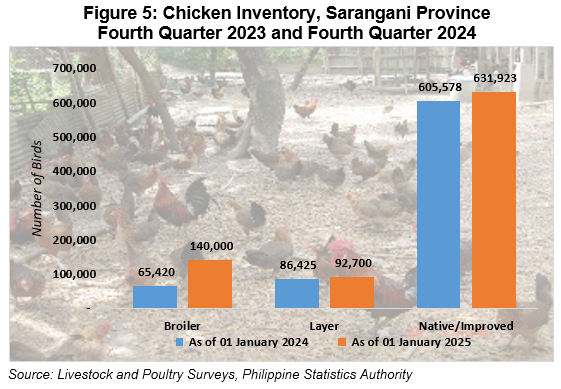
Duck inventory grows by 21.2 percent
Duck inventory as of 01 January 2025 grew by 21.2 percent, from 44,473 birds in the same period last year to 53,889 birds. (Figure 6)

Swine and Native/Improved Chicken lead livestock and poultry inventory
In terms of contribution, swine remained the dominant contributor to the province’s livestock inventory in the fourth quarter of 2024, accounting for 46.3 percent of the total population. Carabao contributed 21.6 percent share, closely followed by goat with a 21.3 percent share. Cattle contributed the smallest share among the major livestock types, at 10.9 percent (Figure 7).
In the poultry sector, native/improved chicken comprised the largest portion of the inventory, making up 68.8 percent of the total population. Broiler chicken accounted for 15.2 percent, while layer chickens and ducks contributed 10.1 percent and 5.9 percent, respectively. (Figure 8)
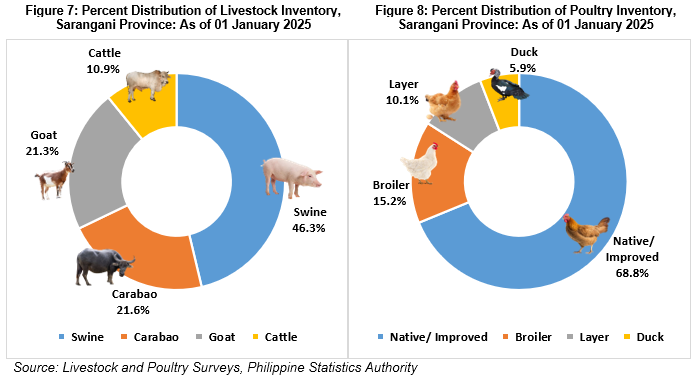
TECHNICAL NOTES
Data for this special release were collected by the Philippine Statistics Authority (PSA) through the two major agricultural surveys, namely: Backyard Livestock and Poultry Survey (BLPS) and Commercial Livestock and Poultry Survey (CLPS). BLPS and CLPS are conducted quarterly and collect data in household and establishment samples. The BLPS and CLPS generate estimates on supply, disposition, average farmgate price, and other related data of livestock and poultry commodities at the household level and from establishments, respectively.
Animal Population (also Animal Inventory) – the actual number of animals (in head/bird) present in the establishment as of a specific reference date regardless of ownership.
Livestock – farm animals kept or raised for consumption, work or leisure. In general, poultry is separated as a distinct group of farm animals. For purposes of census and surveys, livestock covers only those that are tended and raised by an operator.
• Carabao – a local term for water buffalo. It is a domesticated livestock characterized by its heavy built, low and wide body used in farms as draft animal and also suitable for milk production.
• Cattle – a general term for domesticated bovine animals held as property or raised for use.
• Goat – a domesticated hollow-horned ruminant mammal raised in farms.
• Swine – a domesticated animal characterized by a stout body, short legs with a long mobile snout and is commonly known as pig. This includes foreign breed, domestic wild pigs (baboy damo), and native breeds such as Q-Black, Markaduke, Sinirangan, ISUbela, Benguet, and Yookah.
Poultry – a collective term for all domesticated avian for the purpose of food consumption or, the carcass of such avian are processed for human consumption.
• Broiler – strains of foreign breeds of chicken, especially raised for meat purposes only.
• Duck – a general term for waterfowl.
• Layer – foreign strain chicken regardless of age, raised mainly for egg production.
• Native/Improved Chicken – a common backyard fowl that is a mixture of native breed and foreign breed/s which includes Banaba, Bolinao, Paraoakan, Darag, Camarines, and Joloano.
